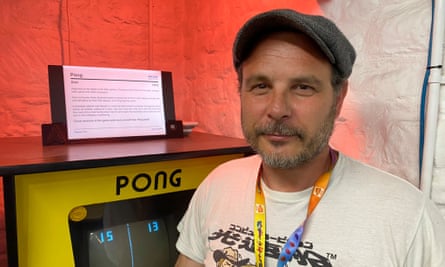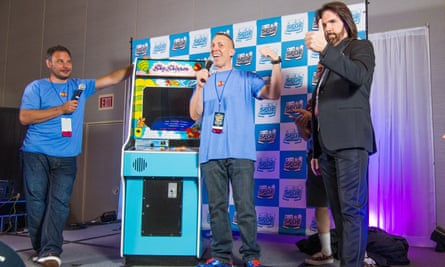Nintendo’s arcade games were hit and miss in early days, with titles such as Monkey Magic and Space Firebird failing to leave much of a lasting impression. That all changed in the summer of 1981 with the release of the all-conquering Donkey Kong (designed by a young Shigeru Miyamoto), which went on to become one of the bestselling arcade games of all time, as well as marking the debut of Mario.
But that same year, Miyamoto worked with director Genyo Takeda on an arcade game that has since been all but forgotten. Sky Skipper featured giant gorillas, just like Donkey Kong, but here the player was piloting a biplane and collecting anthropomorphic playing cards.
The story goes that Sky Skipper was produced in limited numbers in 1981 for testing in Japanese arcades, but the response was poor. Around a dozen cabinets were then shipped to Nintendo of America (NOA) for testing in the US, and the reception was similarly lukewarm. Howard Phillips – who later went on to become a spokesperson for NOA, and who was working in Nintendo’s warehouse at the time that Sky Skipper came in – recalled it as being “trippy” and “not very good”.

The graphics were certainly startling for 1981, featuring a riot of colours and a screen-filling star explosion when the biplane crashed. But it was also confusing: both the playing cards and the gorillas leap into the air, and it’s not immediately clear which things players need to collect and which they should avoid. Not ideal for an arcade experience that needs to be grasped within the first few seconds.
With the game deemed to be a dud, Sky Skipper was never officially released, and NOA later repurposed the cabinets’ circuit boards to run the 1982 game Popeye, much as many of Nintendo’s earlier Radar Scope cabinets had been reborn as Donkey Kong machines. Sky Skipper had in effect been erased from existence. Almost.
Back in 2015, Alex Crowley had developed a passion for collecting old Nintendo arcade machines. He’d already managed to bag a few real rarities for his collection, such as Sheriff and Space Launcher, but he was most intrigued by Sky Skipper since there was so little information on it. All he had was a flyer showing photographs of the machine. But, mysteriously, the game had been uploaded to MAME – an emulator system for arcade games – in 2002, which proved that an original Sky Skipper PCB (printed circuit board) must be out there somewhere. Then, a Sky Skipper PCB that had been converted to run Popeye suddenly came up for auction in Sweden. But no schematics for the board existed, and it seemed there was no way to reverse-engineer it to run Sky Skipper.

Not long after that, Crowley went on a raid in the north of England. “It’s not a raid where you wear balaclavas or anything,” he says over a video call: instead, it’s the term collectors use when hunting through the warehouses of defunct arcade operators in the hope of rare finds. While picking through piles of ancient PCBs, Crowley came across one labelled Popeye – but closer inspection revealed that the board was inscribed with the code TNX01, the same code as the repurposed Sky Skipper PCB board in Sweden. It was the discovery of a lifetime. He now had his hands on one of the rarest circuit boards in existence.
Crowley then bought the Swedish Sky Skipper board, and handed both PCBs over to his engineer friend, Mark Whiting. It would be next to impossible to reverse-engineer one board on its own with no schematics, but with two identical boards, Whiting could cross-reference between them to painstakingly work out the functions of each chip. “And gradually, over a month, he kept calling me up to say ‘I’ve got a bit of progress’,” recalls Crowley, as first the graphics then the sound sparked into life. The hardest part was working out how to bypass the security chip, designed to prevent the PCB from being copied. But eventually Whiting got around it and was able to download the MAME code on to the board, enabling it to play Sky Skipper for the first time in nearly 25 years.
Then, Crowley set about recreating the cabinet by repurposing an old Popeye machine, which shared the exact dimensions of the Sky Skipper original. He asked Olly Cotton, the owner of Arcade Art Shop in Cornwall, south-west England, to recreate the original Sky Skipper cabinet artwork based on the arcade flyer. But the flyer photos were in black and white, so Cotton could only make a best guess at what the original colours might have been. Meanwhile, Crowley sold the second Sky Skipper PCB to US arcade collector Whitney Roberts, with the agreement that Roberts would help in the restoration project. Then came a momentous breakthrough.

Roberts ran into Billy Mitchell, the champion Donkey Kong player and star of the movie King of Kong, at a gaming convention. He asked Mitchell whether he knew anything about Sky Skipper, and Mitchell replied that he’d actually played on a Sky Skipper cabinet at NOA’s headquarters in Washington. Crowley says: “I had heard this rumour that Sky Skipper was in the lobby at Nintendo of America. But to hear from the horse’s mouth, to hear it from Billy Mitchell that he’d actually seen it, that was really … that was just like, wow.”
Mitchell agreed to use his contacts to put Roberts in touch with Don James, executive vice-president of NOA, and in November 2016 Roberts was invited to visit their headquarters. He was guided into a room that was empty – except for the fabled Sky Skipper cabinet sat right in the centre. “I remember waiting that day, waiting for the pictures to come through, and just being absolutely blown away,” recalls Crowley. “Seeing this cabinet that I’d been searching for, for years. To see it actually sitting there existing was just incredible.”
Roberts was able to confirm that the PCB inside the cabinet was the same as the ones he and Crowley had, and he took high-resolution scans of the cabinet’s artwork that would enable them to create an exact replica. In June 2017, Roberts unveiled his recreated Sky Skipper cabinet at an event in Georgia attended by Mitchell. A few months later, Crowley held a similar unveiling at Arcade Club in Bury, Greater Manchester, in England. Crowley’s machine is now available for the public to play at Arcade Archive near Stroud in Gloucestershire.
But that’s not quite the end of the story. There’s still the intriguing question of how Sky Skipper ended up on MAME way back in 2002, considering that only one Sky Skipper cabinet existed at the time.
Julian Eggebrecht, the co-founder of game developer Factor 5, is able to shed some light on the matter. Eggebrecht is a keen arcade collector, and he tells me over email that he spotted the Sky Skipper cabinet at NOA’s headquarters at the time Factor 5 was working on the GameCube title Star Wars Rogue Squadron II: Rogue Leader. He struck a deal with NOA: if Factor 5 was able to finish Rogue Leader ready for release at the end of 2001, Eggebrecht’s studio would be permitted to borrow Sky Skipper for a few months.
With Rogue Leader successfully completed on time, NOA stayed true to its word. But Eggebrecht spotted something wrong with the machine when it arrived. “When I fired it up the colours seemed to be … not OK, especially compared to one or two legacy photos I found,” he says. He was given permission to open up the machine, and discovered that one of the chips governing the game’s colour palette was dead.
Eggebrecht needed the colour palette data to fix the machine, but NOA didn’t have it on file. So he contacted Nintendo Japan, who said the only person who might still have the master files was Takeda, the game’s director, who had since gone on to head Nintendo’s hardware division. “I had met Takeda-san multiple times due to our involvement in the GameCube/Wii chip design. So I reached out and to my big surprise he immediately and very enthusiastically responded and promised to dig into his archive and see if he still had the file so that I could repair the machine,” Eggebrecht says.

“He did indeed find it and sent it to me, and I repaired NOA’s machine – and he ended the note on a humorous tone saying he fondly remembered Sky Skipper since it was the only time Miyamoto-san worked for him.”
Eggebrecht downloaded the ROM files for Sky Skipper while the cabinet was in Factor 5’s possession, but he says he doesn’t know how the files ended up on MAME. “I certainly gave NOA a complete set of verified ROM files for their archive,” he says. “Never heard about it after that.”
In June 2018, Nintendo released an arcade-perfect version of Sky Skipper on the Switch, so now everyone can easily play this almost forgotten slice of Nintendo’s arcade history. But the question still remains of how many other original Sky Skipper PCBs might still be out there. Since Crowley’s discovery, a handful of other Sky Skipper PCBs that had been converted to run Popeye have turned up in Europe, Japan and the US. But could there be more? Could there even be another complete, original cabinet?
Sky Skipper was ported to the Atari 2600 by Parker Brothers in 1983. Parker Brothers designer Steve Kranish recalled in 2007 that the firm was given a cocktail table version of Sky Skipper to do the conversion, different from the upright cabinet in the NOA archive. What happened to that machine? Did it survive? There could well be more twists in the Sky Skipper tale yet.
